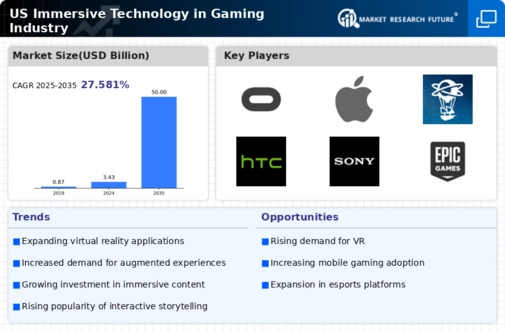Expansion of Online Gaming Platforms
The expansion of online gaming platforms is a crucial driver for the immersive technology-in-gaming-industry market. With the rise of cloud gaming services, players can access high-quality games without the need for expensive hardware. This accessibility is encouraging more gamers to explore immersive technologies, as they can experience VR and AR games through various devices. As of 2025, the online gaming market is expected to reach $100 billion, with a significant portion attributed to immersive gaming experiences. This trend indicates that the immersive technology-in-gaming-industry market will likely thrive as online platforms continue to evolve and attract a broader audience.
Advancements in Hardware Capabilities
The immersive technology in gaming market is experiencing a surge in hardware advancements, particularly in graphics processing units (GPUs) and head-mounted displays (HMDs). These innovations enhance the realism and interactivity of gaming experiences, making them more appealing to consumers. For instance, the introduction of GPUs with ray tracing capabilities has improved visual fidelity, allowing for more lifelike environments. As of 2025, the market for high-performance gaming hardware is projected to reach approximately $40 billion, indicating a robust demand for cutting-edge technology. This trend suggests that as hardware becomes more sophisticated, it will likely drive further growth in the immersive technology-in-gaming-industry market.
Integration of AI in Game Development
The integration of artificial intelligence (AI) in game development is transforming the immersive technology-in-gaming-industry market. AI technologies are being utilized to create more dynamic and responsive gaming environments, enhancing player engagement. For example, AI-driven non-player characters (NPCs) can adapt to player behavior, providing a more personalized experience. This innovation not only improves gameplay but also reduces development time and costs. As AI continues to evolve, its impact on the immersive technology-in-gaming-industry market is likely to increase, with estimates suggesting that AI could account for up to 30% of the market's growth by 2027.
Rise of Esports and Competitive Gaming
The rise of esports and competitive gaming is significantly influencing the immersive technology-in-gaming-industry market. As esports gains popularity, there is a growing demand for immersive experiences that enhance spectator engagement. This trend is leading to the development of VR and AR applications specifically designed for esports events, allowing fans to experience games from unique perspectives. The esports market is projected to surpass $1.5 billion by 2025, indicating a lucrative opportunity for immersive technology providers. This growth suggests that the immersive technology-in-gaming-industry market will continue to benefit from the increasing integration of immersive experiences in competitive gaming.
Growing Consumer Demand for Immersive Experiences
Consumer preferences are shifting towards more immersive gaming experiences, which is a key driver for the immersive technology-in-gaming-industry market. Surveys indicate that around 70% of gamers express a desire for more engaging and interactive gameplay. This demand is pushing developers to create content that leverages virtual reality (VR) and augmented reality (AR) technologies. The increasing availability of affordable VR headsets is also contributing to this trend, as more players can access immersive experiences. Consequently, the market is expected to expand significantly, with projections suggesting a growth rate of over 25% annually in the coming years.
























Leave a Comment